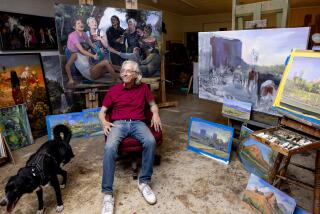Artist Feathers His Nest by Flying Corporate Coop
Lee Jayred of Thousand Oaks doesnât fit many of the common conceptions of a successful professional artist. For starters, he has never taken an art class. Nor has the 51-year-old Jayred suffered through a time of financial hardship and commercial rejection. When, at 39, he made the jump from pharmaceutical company executive to wildlife artist, the transition went smoothly.
Further, Jayred does not have the indifference to money that the archetypical artist professes. Rather, he credits his success to his business skills as much as his talent. And he never has encountered the sort of emotional storm that might make an artist stop working for a time or cut off an ear.
To casual acquaintances Jayred and his wife, Diantha, who helps sell the artwork, may seem to have had far more than their share of good luck. Few artists, self-taught or otherwise, make a living from their paintings and drawings. Fewer still do well enough to own a large, comfortable home and to put three children through college.
Persistence Is Key
But the Jayreds have had an ally stronger than luck, and it is a common thread in many success stories. They have persisted.
âPeople tell me, âIâm so envious of you. You have your cake and eat it too,â â Jayred said in his backyard studio one recent afternoon. âBut they donât know how hard we work. I start in the morning every day, and Iâm here drawing for six or eight hours. At night after dinner my wife and I might discuss business for two hours or so. Then, when thereâs a show, we get up at 5 a.m., and the day wonât end until 11 or midnight. I wouldnât have it any other way, but it is a lot of work.â
Jayred draws and paints wildlife. He is tall, with blue eyes and graying, arched eyebrows, and his regular walks and camping trips keep him trim. Although the subjects of his work include such mammals as foxes, antelope and mountain lions, his specialty is birds.
âIâve always loved birds--especially raptors, the birds of prey,â he explained. âI donât know why, but I have. Itâs like with Auduboners. They canât tell you why theyâre out there looking at birds, but they do it anyway.â
Early Interest in Nature
He came by his interest in wildlife early.
âMy parents were divorced when I was 3 months old,â Jayred said, âand I grew up with my grandparents in a little town called Imlay in northwestern Nevada. There were only a couple of hundred people there. I opened my front door and I was in nature. I was always in the wild, collecting bird eggs and arrowheads and observing.â
Jayred remembers seeing a mountain lion for the first time at age 5. He also recalls a feeling he had at age 9 or 10, when he started sketching the animals he encountered while exploring.
âI realized that the combination of being able to draw nature and to do it for a living would be a wonderful thing. The idea planted a seed.â
Jayred bounced around during his teen years. For a time he lived with his mother and stepfather in Reno. As had his grandfather, Jayredâs stepfather encouraged the boyâs interest in wildlife. At 13 he took up falconry, a sport he would pursue for the next 10 years.
After Jayred married and finished a stint in the Army, he began selling encyclopedias. âI called on a guy who happened to be a salesman for a pharmaceutical company called Broemmel, which was headquartered in San Francisco. The guy didnât buy an encyclopedia, but he liked my pitch and recommended me for a job selling with Broemmel.â
For the next 15 years Jayred was caught up in the competitiveness of corporate life. He rose to national sales manager and later to vice president and general manager. His family--by now there were three children, Yvonne, Elena and Michael--moved 12 times. But Jayred retained his interest in wildlife. While living in Marin County he earned his bird-banding license, a federal permit that allows a person to capture, weigh and band birds as part of ornithological studies.
âTwo mornings a week Iâd get up at 4:30 and drive an hour and a half from Marin to Point Reyes Bird Sanctuary,â he recalled. âIâd help the ornithologist do his work, then Iâd drive to my job in San Francisco.â
Helped Engineer Buy-Out
Broemmel specialized in products for the ear, nose and throat, the best known of which was Isophrin nose drops. Jayred and others believed that a buy-out of the company would give it a boost by providing capital to develop other products. He began courting suitors, and in 1972 Broemmel was purchased by Riker Laboratories, a division of Minnesota Mining & Manufacturing Co. Jayred moved to Thousand Oaks and began working at Rikerâs headquarters in Northridge.
âIt was a very different atmosphere,â he said. âI went from a very free position where I reported only to the owners to a situation where I had no authority to make decisions. An idea would have to go from one committee to another committee. I got a feeling of being very closed in.
âAfter a year and a half I weighed 210 pounds, which is 30 more than I do today. I was very uncomfortable. I sat down with my family and said, âI donât like what Iâm doing. Iâve always wanted to be an artist. Will you take the chance with me?â And they said yes.â
Jayred hadnât sold even one work of art. But people regularly told him that they liked his drawings and paintings. And he had severance pay amounting to a yearâs salary, plus stock option money, to cushion the transition. He and his wife began making the rounds of galleries, malls, outdoor festivals and art competitions, going anywhere they might sell something or meet a collector.
They took three works to the first show and sold two, for a total of $65. Today Jayredâs lithographs sell for $75 to $250 and his originals bring $275 to $3,500.
âI think the reason weâve been so successful is my background in marketing, new product development and finance,â he said. âIt has made selling much simpler. Early on, I saw we had to get into prints so people at all income levels could afford something. So in 11 years Iâve done 87 editions of lithographs.â
Most of Jayredâs editions are limited to 325 prints. He said about a third of them have sold out. The latest is of six fat cedar waxwings resting on a branch. Jayred draws the original picture in a colored pencil called Prismacolor and has it lithographed onto museum-quality paperboard by a firm in El Segundo.
Birds donât oblige artists by posing, so Jayred takes color photographs of his subjects--about 3,000 pictures a year. John Audubon, Americaâs best-known wildlife artist, solved the problem by shooting his models with a gun and posing them dead.
âSometimes the birdâs posture isnât right,â Jayred said of the masterâs work, âbut Audubonâs accomplishments were awesome. He had no backing and no photographs, but he did a tremendous amount of work and itâs very good.â
Jayred believes that regular visits to the habitats of his subjects are needed to keep his work vibrant. He travels to beaches in Baja California and Ventura County to watch shore birds; to Twin Lakes near Mammoth Mountain for warblers, hummingbirds and swallows, and to the Black Rock desert in northwestern Nevada for eagles, falcons and ducks. He dreams of a trip to Africa.
More to Read
The biggest entertainment stories
Get our big stories about Hollywood, film, television, music, arts, culture and more right in your inbox as soon as they publish.
You may occasionally receive promotional content from the Los Angeles Times.










